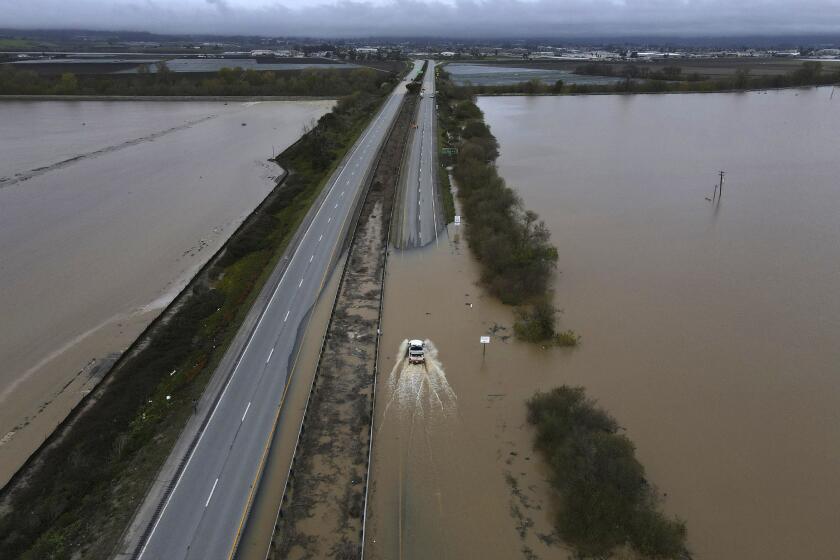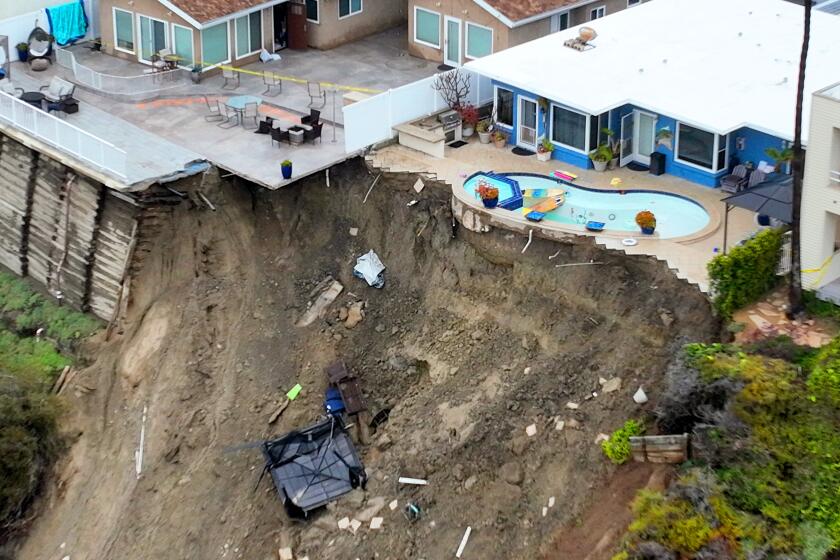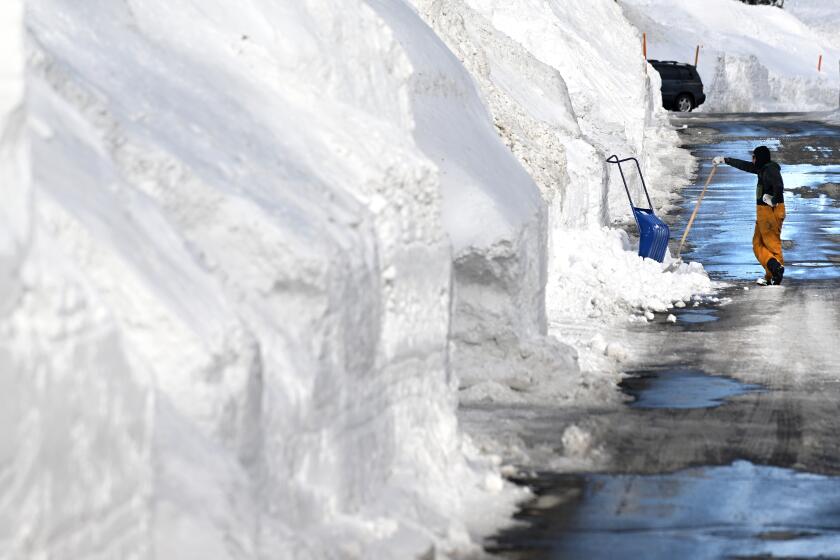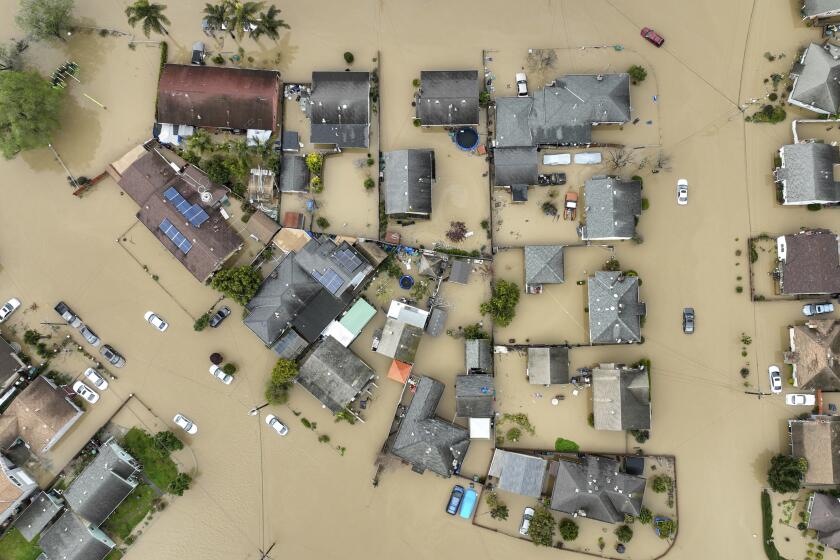Age, drought, rodents and neglect weaken California levees, heightening flood danger
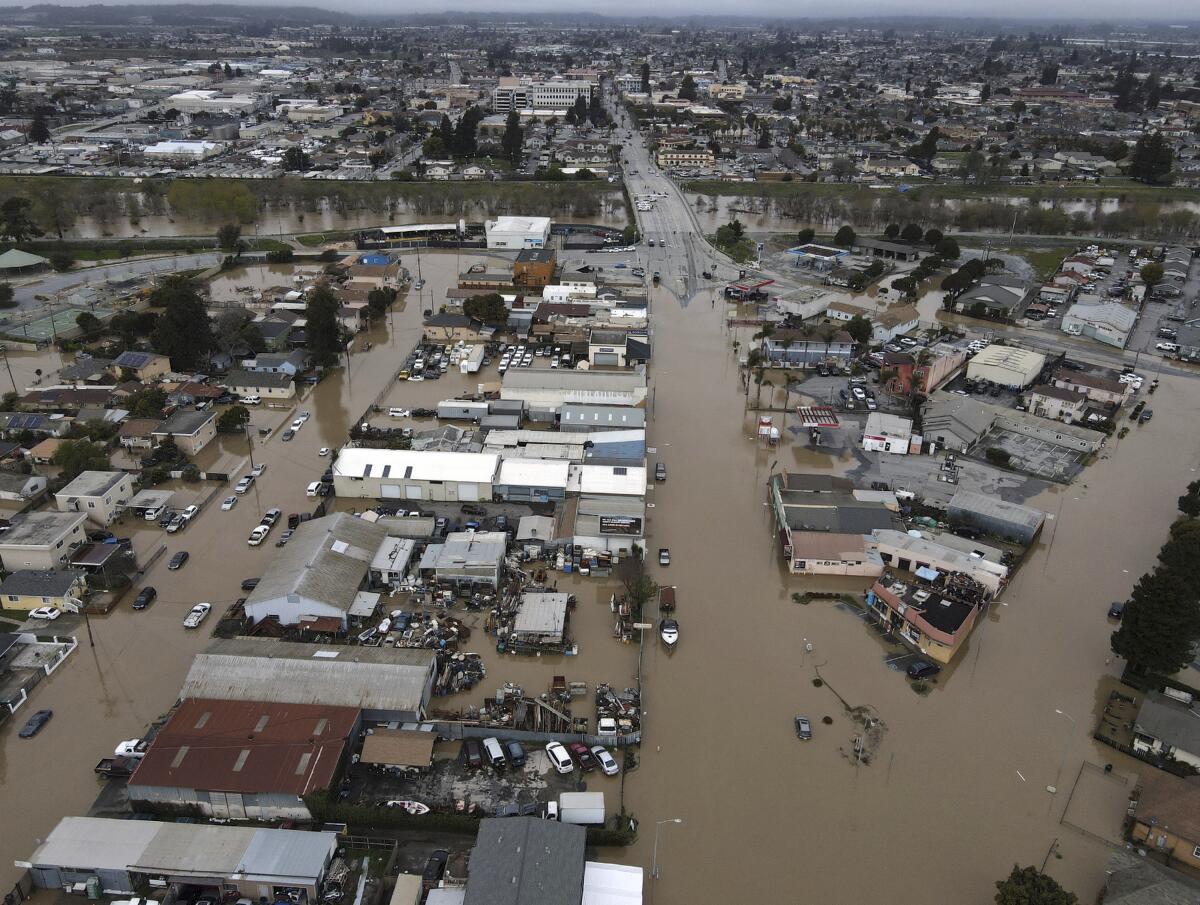
- Share via
The levee breach that left an entire California town underwater this weekend is putting a spotlight on how the state’s vital flood control infrastructure is being weakened by age, drought, climate change, rodents and neglect — leaving scores of communities at risk.
On Friday night, the swollen Pajaro River burst through the worn-down levee, flooding the entire town of Pajaro and sending its roughly 3,000 residents into what officials are now estimating to be a multi-month-long exile. A second breach was reported on Monday.
For decades, the levee was ignored by the federal government — never rising to the status of a fix-worthy project — despite repeated pleas, breaches, floods and even two deaths.
“Yeah, the money wasn’t there because the prioritization wasn’t there,” said Mark Strudley, executive director of the Pajaro Regional Flood Management Agency.
And as the communities and local government agencies begged for help and funding, the levee aged, eroded and, in some places, sank.
The situation is by no means unique to Pajaro. Experts say similar weaknesses plague levee systems across California and the nation.
As climate change threatens to intensify and exacerbate extreme weather events — such as flooding and even drought — the unease and desperation of residents and emergency responders in communities near these crumbling systems is growing.
“We all know that there’s a lot of economically disadvantaged communities that are built in natural disaster-prone areas,” Strudley said. “That’s just the very unfortunate way the planning and development process has worked over the past 100 plus years in the United States.”
For years, experts had been warning Monterey and Santa Cruz County that the levee along the Pajaro River could fail.
Throughout Northern California, the Central Valley and the Sacramento-San Joaquin River Delta, there are more than 13,000 miles of levees designed to protect dry land from floods, deliver drinking water, and protect homes, businesses, and agriculture from flooding.
According to work by Farshid Vahedifard — a professor of civil engineering at the Mississippi State University — a high percentage were constructed by settlers in the mid- to late 19th century to protect agricultural lands from flooding.
“And they’ve been worn down, just like anything else,” Strudley said. “They have a limited life span.”
In most cases, Strudley and Vahedifard said, the levees were built with poorly compacted, unengineered mixtures of sandy, clayey and organic soils, material “that was scraped up out of the riverbed and used for fill to build the levees,” Strudley said.
California continues to deal with damage from March storms: surging rivers, mudslides, breached levees and displacement in flooded towns.
In addition, they’ve suffered the wear-and-tear of time, rodents, seismic events and drought.
“These things leak long before they get overtopped,” said Strudley, noting that one of the biggest problems is burrowing animals.
In 2011, the California Department of Water Resources examined Northern California’s levee system. The evaluation considered about 1,800 miles of earthworks throughout the Sacramento and San Joaquin River basins and found that more than half of the levees were what they considered “high hazard” — indicating they were in danger of failing during an earthquake or flood event.
And that was before the megadrought, which dried out soils within the levees and underneath them — causing the structures to weaken and lose strength, Vahedifard said.
Drought also hastened subsidence as water districts and users siphoned water from underground aquifers, depressing and sinking the land above.
But until recently, the federal government and the U.S. Army Corps of Engineers did not see these systems — particularly if they were in marginalized or economically disadvantaged communities — as a priority.
As record snows saddle the eastern Sierra Nevada, snowmelt threatens to inundate Los Angeles Department of Water and Power infrastructure.
“The federal funding system for levees and other life protection systems completely disadvantages federally disadvantaged communities, systemically,” said Zach Friend, a Santa Cruz County supervisor whose district encompasses Watsonville and the northern side of the Pajaro River Valley.
He said what happened to the levee in Pajaro could have been prevented had resources been provided to the community to rebuild the levee — something it had been requesting since the 1960s.
“The storms that came that blew out the levee ... are a five- to seven-year-interval storm,” he said. “So if our infrastructure can’t even withhold what really is a relatively regular occurrence storm, climate change — what we are seeing in the future and what it’s going to do to disadvantaged communities — is something beyond the pale.”
He said the cumulative effect of these storms and the “weather whiplash” between severe drought and severe storms “really tests the possibility of how you even build for and plan for that level of resilience toward communities that have been under-invested in for the last 100 years and that are starting at a net negative rebuild.”
The levee failure on the Pajaro River points to larger hazards that California has yet to address in many areas where communities are vulnerable, said Deirdre Des Jardins, an independent water researcher and advocate.
“Pajaro is just the beginning,” Des Jardins said.
Des Jardins has for years urged state and local officials to invest in flood protection infrastructure in areas that are at risk, and she has suggested an effective climate adaptation strategy should focus on “measurable, actionable targets for protection of vulnerable populations.”
“You look at where to invest money to protect lives. And we’re not doing that. We don’t have quantifiable targets about protecting lives and protecting these vulnerable communities,” De Jardins said.
The latest storm will create flooding concerns along much of the California coast and Central Valley, and over the southern Sierra Nevada foothills.
In addition to rural communities like Pajaro, she said that Stockton and neighboring cities face major flood risks due to their reliance on inadequate levees with known seepage problems.
As the federal government continues to re-evaluate how it invests in major infrastructure projects in economically disadvantaged communities, the cost of doing nothing will continue to mount.
“How much flood risk is there in California? A bunch. The reason is pretty simple,” said Jeffrey Mount, a senior fellow at the Public Policy Institute of California. “The economic consequences of even a modest flood are pretty high.”
He said this is especially the case in the L.A. Basin, where the growing likelihood of major flooding overlaps with the increasing value of surrounding properties.
“There is a long legacy of very bad flood management and land use choices along the L.A., San Gabriel and Santa Ana rivers,” Mount said. “That is an equation for high risk because eventually a flood will come and the economic costs will be immense.”
Local, state and federal officials have improved flood control infrastructure in the Sacramento area during the last two decades, which has reduced risk in the area, Mount said.
Still, many low-lying communities in the Central Valley face substantial flood risks. And many farms in and around the Delta sit below sea level, requiring levees to keep water out, Mount said.
“Our flood infrastructure is old,” Mount said, “and is designed for the hydrology of the past, not the future.
“This is going to be a major challenge going forward, particularly because we have increased the potential economic costs of flooding by our land use choices.”
In January, when levees failed along the Cosumnes and Mokelumne rivers and caused deadly flooding, Mount said those failures point to larger hazards. “There are two kinds of levees: Those that have failed, and those that will fail,” he said.
Mount said he is now especially concerned about the immense amount of snowmelt runoff expected from the central and southern Sierra this spring.
Times staff writer Hayley Smith contributed to this report.
More to Read
Sign up for Essential California
The most important California stories and recommendations in your inbox every morning.
You may occasionally receive promotional content from the Los Angeles Times.
